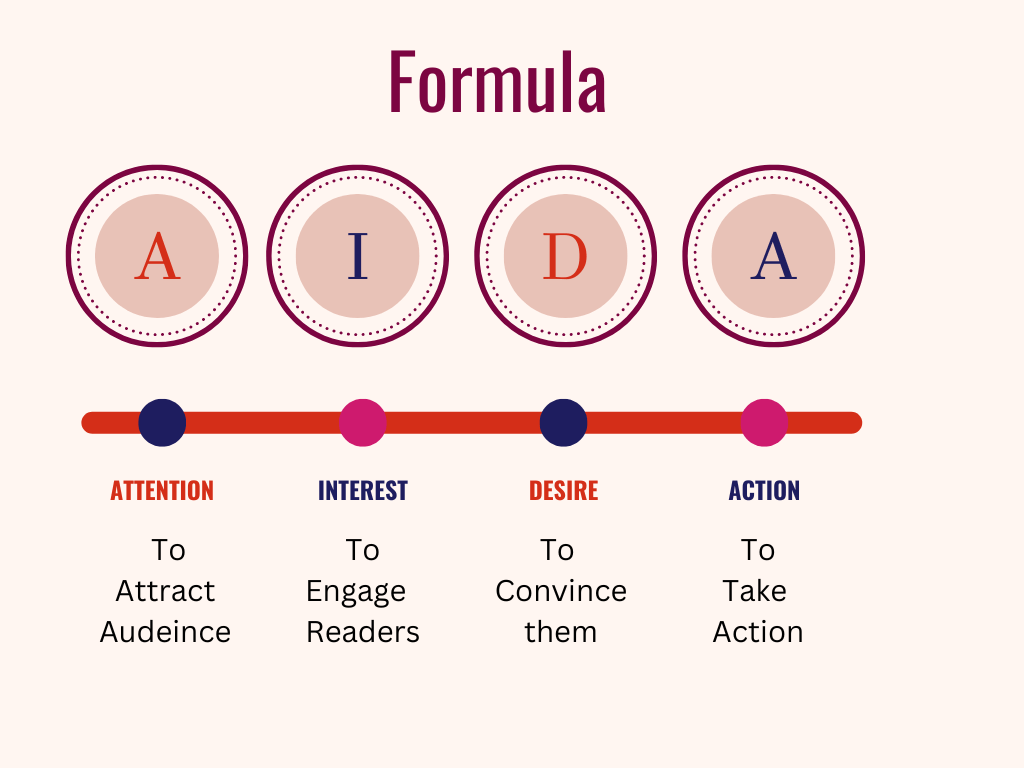In the first part of this blog, we went through what copywriting covers and some important things to consider before writing. Now that you have the things required to make your copy effective, it is time to know the structure of copywriting or any advertisement.
The AIDA Rule

A: Attention
The first thing is to grab the attention of the public. No matter what your copy contains, it is only useful if readers notice it. Your copy must include a special factor to attract readers. In fact, all the elements in a copy are primarily meant to attract the clients' attention. Using images, powerful headlines, memes, or graphics makes your copy attractive.
Write attention-grabbing headlines. Notice how powerful headlines grab your attention? Headlines are highlighted in bold text, making them the most crucial element in any copy. You have to know what works with your target audience. Use designs to get the optimum results, create copies and compare. There are different ways to make attractive headlines but trying to sell the product in the headline is definitely not one.
It takes time to come up with a headline that triggers your potential customers and, at the same time, is relevant to your content. The struggle of writing is nothing compared to crafting a powerful headline. Don't worry about it now. You can think of it once you finish your copy. Once you successfully get your reader's attention, the rest is easy.
I: Interest
The next part is where the copywriters connect the product with viewers. Tell them interesting facts and uses of the product.
After you get the attention of your viewers, now begin with how your product interests the viewers. How can your product benefit the customers? Prioritize benefits over features. Rather than flaunting the features of your product, think more about how they can benefit from using it.
Listen to your user's feedback and think of what they want. What questions might they have? What advice or help can you provide? Reframe the idea to relate it to your readers. Why does it matter to them? What's in it for them? Why should they care about your product? What's the clear message you want them to take away? What value do you offer them?
Involve your readers to make it appealing. Your copy should be informative and helpful for the readers. Otherwise, they would not go through your copy.
D: Desire
Take a step further to change the customer's perspective from liking it to wanting it. Think about how you can relate your product to the customers.
You should take control over your customer and create a buying environment. Get your customers into a buying mood. In fact, the buying environment should be set up starting with the first paragraph of your copy.
Analyze your product and brainstorm the ideas and points that set them apart from your competitors. You should be able to differentiate your product's uniqueness.
Go through the similar products of your competitors and point out what they are missing or doing well. This way, you can identify the selling factor of your product. Study the customer's feedback and think of what they want from your product. Understand your customers, and get to know your target audience and their desires.
A: Action
The final part of every copy, blog, email or advertisement ends with Call To Action (CTA).
CTA is a guide to your readers. You can guide them to your goals if they are interested in your product or service. It is usually seen on landing pages of products, blogs or any advertisement.
Make it simple and eye-catching. Be clear and let your customers know what they are getting into. You can highlight the CTA button with discounts or special offers. Maybe there is a hot offer for the first five buyers or a discount. Use precise words like 'Download Now for Free' or 'Subscribe and Save Money'. Remember that overdoing your CTA button or link would not make it appealing.
Wrapping it Up
Now you know the elements and formulas used in a copy. Check out different ads and practice writing for different products. Understand that it takes time to master copywriting skills.
Practice what we learned, try it out, make a draft, compare, and look for ways to write attention-grabbing headlines. More importantly, make your copy attractive because getting the readers' attention is the first and most important task. Study the headlines and banners of popular websites and learn from them. Study marketing email copies and how they interact with their customers.
It's time to craft your first copy. This will only be a draft, but you will have something to work on later as you develop your skills.
Hope you enjoyed this read. Leave a comment if you have any questions. Subscribe for more!
